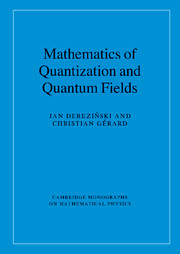Book contents
- Frontmatter
- Contents
- Introduction
- 1 Vector spaces
- 2 Operators in Hilbert spaces
- 3 Tensor algebras
- 4 Analysisin L2 (ℝd)
- 5 Measures
- 6 Algebras
- 7 Anti-symmetric calculus
- 8 Canonical commutation relations
- 9 CCR on Fock space
- 10 Symplectic invariance of CCR in finite-dimensions
- 11 Symplectic invariance of the CCR on Fock spaces
- 12 Canonical anti-commutation relations
- 13 CAR on Fock spaces
- 14 Orthogonal invariance of CAR algebras
- 15 Clifford relations
- 16 Orthogonal invariance of the CAR on Fock spaces
- 17 Quasi-free states
- 18 Dynamics of quantum fields
- 19 Quantum fields on space-time
- 20 Diagrammatics
- 21 Euclidean approach for bosons
- 22 Interacting bosonic fields
- References
- Symbols index
- Subject index
17 - Quasi-free states
- Frontmatter
- Contents
- Introduction
- 1 Vector spaces
- 2 Operators in Hilbert spaces
- 3 Tensor algebras
- 4 Analysisin L2 (ℝd)
- 5 Measures
- 6 Algebras
- 7 Anti-symmetric calculus
- 8 Canonical commutation relations
- 9 CCR on Fock space
- 10 Symplectic invariance of CCR in finite-dimensions
- 11 Symplectic invariance of the CCR on Fock spaces
- 12 Canonical anti-commutation relations
- 13 CAR on Fock spaces
- 14 Orthogonal invariance of CAR algebras
- 15 Clifford relations
- 16 Orthogonal invariance of the CAR on Fock spaces
- 17 Quasi-free states
- 18 Dynamics of quantum fields
- 19 Quantum fields on space-time
- 20 Diagrammatics
- 21 Euclidean approach for bosons
- 22 Interacting bosonic fields
- References
- Symbols index
- Subject index
Summary
Suppose that we have a state ψ on the polynomial algebra generated by the fields ϕ(y) satisfying the CCR or CAR relations. For simplicity, assume that ψ is even, that is, vanishes on odd polynomials. Clearly, this state determines a bilinear form on Y given by the “2-point function”
We say that a state ψ is quasi-free if all expectation values
can be expressed in terms of (17.1) by the sum over all pairings.
This chapter is devoted to a study of (even) quasi-free states, both bosonic and fermionic. This is an important class of states, often used in physical applications. Fock vacuum states belong to this class. It also includes Gibbs states of quadratic Hamiltonians.
Representations obtained by the GNS construction from quasi-free states will be called quasi-free representations. They are usually reducible. Many interesting concepts from the theory of von Neumann algebras can be nicely illustrated in terms of quasi-free representations.
Quasi-free states can be easily realized on Fock spaces, using the so-called Araki–Woods, resp. Araki–Wyss representations in the bosonic, resp. fermionic case. Under some additional assumptions, in particular in the case of a finite number of degrees of freedom, these representations can be obtained as follows. First we consider a Fock space equipped with a quadratic Hamiltonian. Then we perform the GNS construction with respect to the corresponding Gibbs state. Finally, we apply an appropriate Bogoliubov rotation.
- Type
- Chapter
- Information
- Mathematics of Quantization and Quantum Fields , pp. 423 - 474Publisher: Cambridge University PressPrint publication year: 2013



